Electric Vehicle Battery Electrolyte Market Size
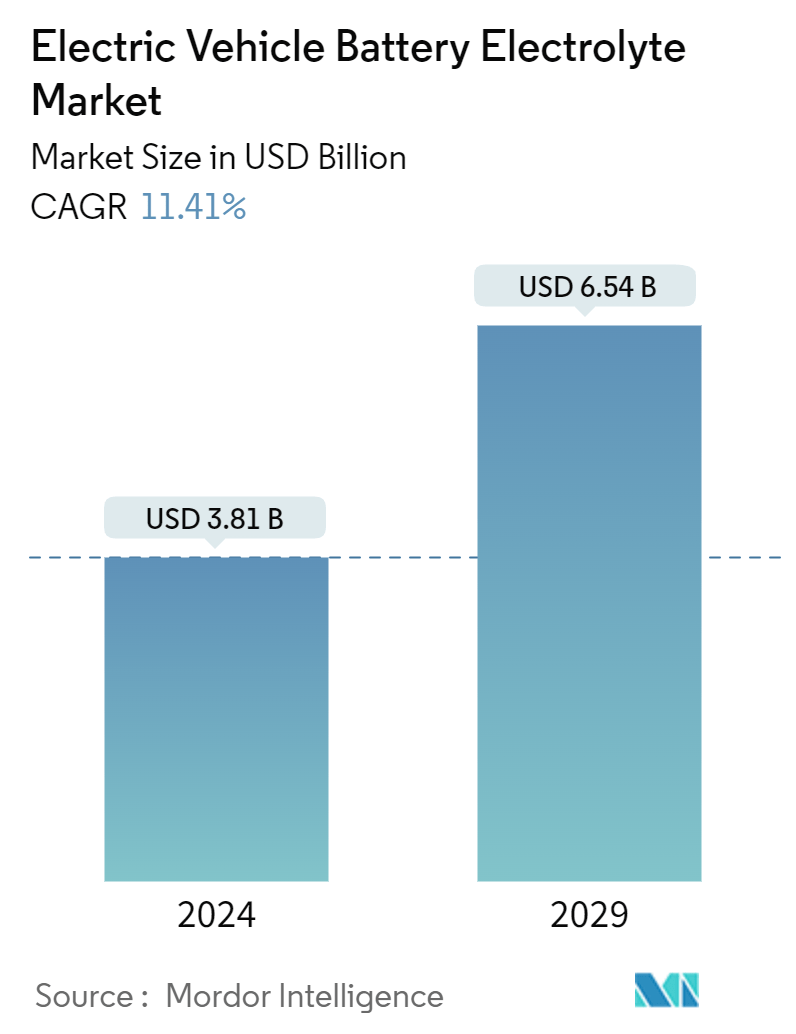
| Study Period | 2019 - 2029 |
| Market Size (2024) | USD 3.81 Billion |
| Market Size (2029) | USD 6.54 Billion |
| CAGR (2024 - 2029) | 11.41 % |
| Fastest Growing Market | Asia Pacific |
| Largest Market | Asia Pacific |
| Market Concentration | Medium |
Major Players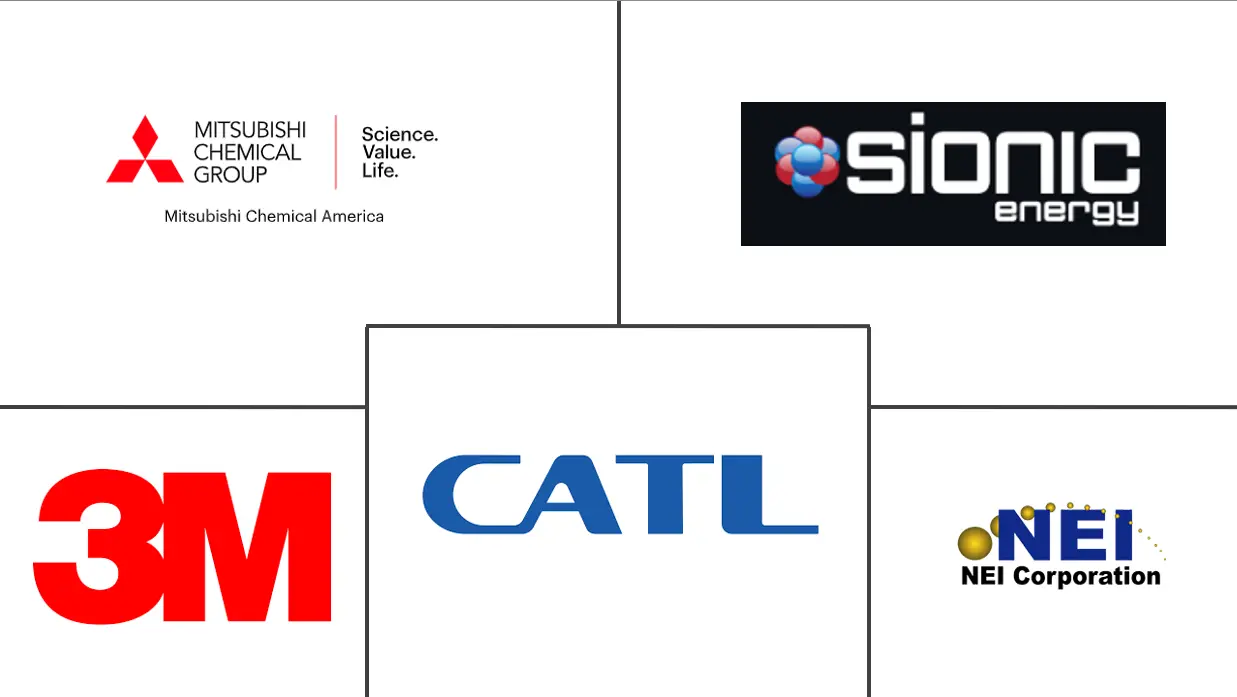
*Disclaimer: Major Players sorted in no particular order |
Electric Vehicle Battery Electrolyte Market Analysis
The Electric Vehicle Battery Electrolyte Market size is estimated at USD 3.81 billion in 2024, and is expected to reach USD 6.54 billion by 2029, growing at a CAGR of 11.41% during the forecast period (2024-2029).
- Over the medium term, factors such as the increasing demand for electric vehicles and supportive government initiatives are expected to drive the market during the forecast period.
- On the other hand, high costs of advanced electrolytes and safety concerns are expected to hinder the market growth during the forecast period.
- However, technological innovations and expansion in emerging battery materials are expected to provide significant opportunities for the market in the coming years.
- Asia-Pacific is estimated to dominate the market due to the increasing adoption rate of electric vehicles across the various countries in the region.
Electric Vehicle Battery Electrolyte Market Trends
The Lithium-ion Batteries Segment to Dominate the Market
- Lithium-ion batteries have traditionally been used mainly in consumer electronic devices like mobile phones and personal computers. Still, due to low environmental impact, they are increasingly being redesigned as the power source of choice in hybrid and the complete electric vehicle (EV) range. EVs do not emit any CO2, nitrogen oxides, or other greenhouse gases.
- In 2023, the demand for electric vehicle (EV) batteries surged by 40% compared to the previous year, driven by rising EV sales across all markets, particularly in Europe and the United States. China continues to lead in battery production, especially for heavy-duty batteries, with approximately 12% of its production being exported. Meanwhile, Europe is making significant strides, with forecasts from BloombergNEF suggesting that its share of global battery production could reach 31% by 2030.
- As the demand for electric vehicles escalates worldwide, effective and reliable battery electrolytes have become paramount, fostering significant advancements in electrolyte formulations and technologies.
- One of the primary trends influencing the lithium-ion battery electrolyte market is the continuous decline in the price of lithium-ion batteries. For instance, the average price of lithium-ion batteries fell to around USD 139 per kilowatt-hour (kWh) in 2023, representing a significant decrease of over 82% since 2013. Projections indicate that prices could decline to below USD 113/kWh by 2025 and reach USD 80/kWh by 2030. This downward pricing trend makes electric vehicles more affordable for consumers and encourages manufacturers to explore new electrolyte compositions and improve existing ones, enhancing battery performance and longevity.
- The increasing penetration of electric vehicles in emerging markets is also driving the growth of the lithium-ion battery electrolyte segment. Governments worldwide are implementing policies and incentives to promote electric vehicle adoption.
- In 2023, the US government announced a goal to have 50% of all new vehicle sales electric by 2030. The White House also announced public and private commitments to support America's historic transition to electric vehicles under the EV Acceleration Challenge.
- This leads to a surge in battery production and electrolyte demand. As countries prioritize reducing greenhouse gas emissions and transitioning to cleaner energy sources, the role of efficient battery electrolytes becomes increasingly critical in achieving these sustainability goals.
- Hence, as the market evolves, the focus on sustainability and alternative technologies is expected to shape the future landscape of the battery electrolyte segment globally, contributing to a greener automotive industry.
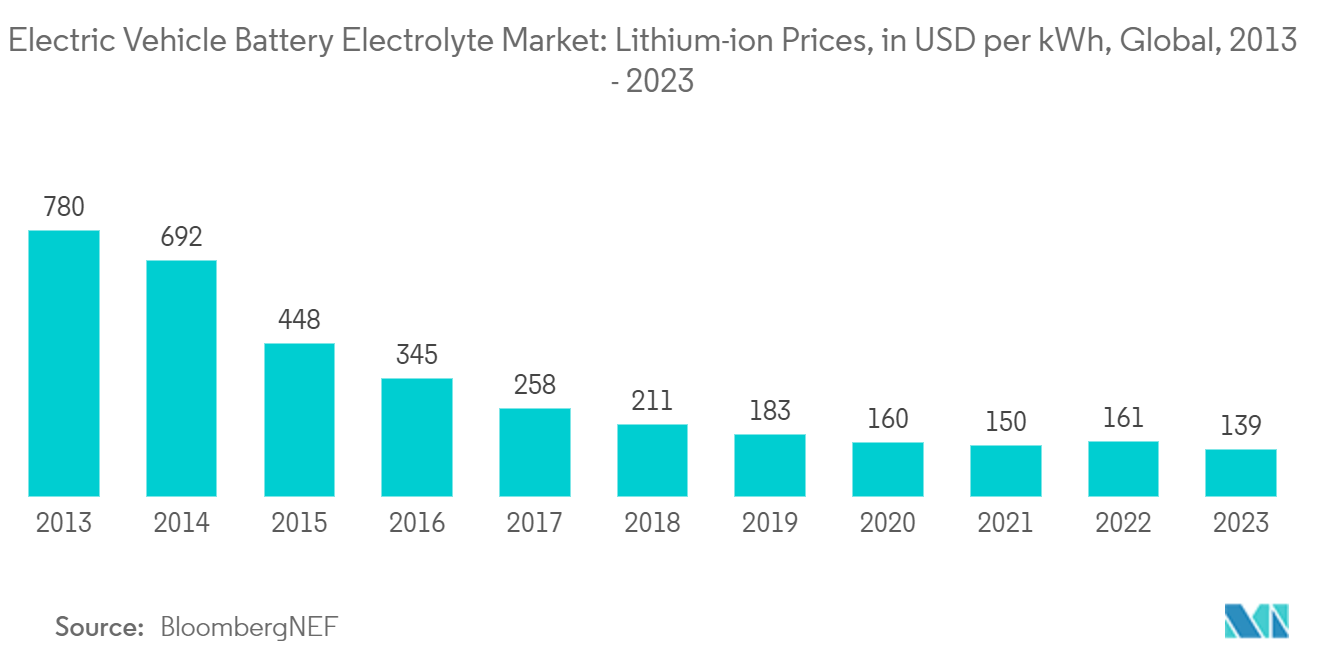
Asia-Pacific is Expected to Dominate the Market
- The Asia-Pacific electric vehicle (EV) battery electrolyte market is witnessing remarkable growth, primarily driven by China's leading EV production and sales position. With global electric vehicle sales skyrocketing from 1.06 million in 2019 to 8.1 million in 2023, an increase of over 650%, China's robust demand for battery electrolytes plays a pivotal role in this expansion.
- Chinese companies are at the forefront of battery innovation, continually enhancing the performance and efficiency of lithium-ion batteries. A significant breakthrough occurred in March 2024, as researchers unveiled a new electrolyte design that greatly enhances the charging speed and expands the operational temperature range of lithium-ion batteries for electric vehicles. This innovative design allows for full charge and discharge cycles within 10 minutes at room temperature and ensures battery reversibility across a wide temperature span from -70°C to 60°C. Such advancements enhance battery efficiency and improve safety, making lithium-ion batteries more reliable for electric vehicles.
- The large-scale production of lithium-ion batteries has contributed to the decline in manufacturing costs, making electric vehicles more accessible to consumers. Lower labor costs and increased competition among manufacturers have enhanced overall profitability, enabling broader market reach. These cost efficiencies are critical in encouraging more consumers to transition to electric vehicles, thereby driving demand for electrolytes.
- In addition to China, other countries in Asia-Pacific, such as Japan and South Korea, are making significant strides in the electric vehicle battery electrolyte market. Japan's focus on developing solid-state and sodium-ion batteries promises to deliver better performance at lower costs, while South Korea is investing heavily in battery production and innovation.
- For instance, in April 2024, Japanese researchers identified a stable, highly conductive material suitable for use as an electrolyte in solid-state lithium-ion batteries. This new material boasts ionic conductivity surpassing that of any previously known oxide solid electrolytes and operates effectively over a wide temperature range.
- The Asia-Pacific electric vehicle battery electrolyte market is poised for continued growth, fueled by technological advancements, strong government support, cost efficiencies, and an expanding infrastructure. As these factors converge, the region is expected to maintain its dominance in the market for EV battery electrolytes, shaping the future of sustainable transportation.
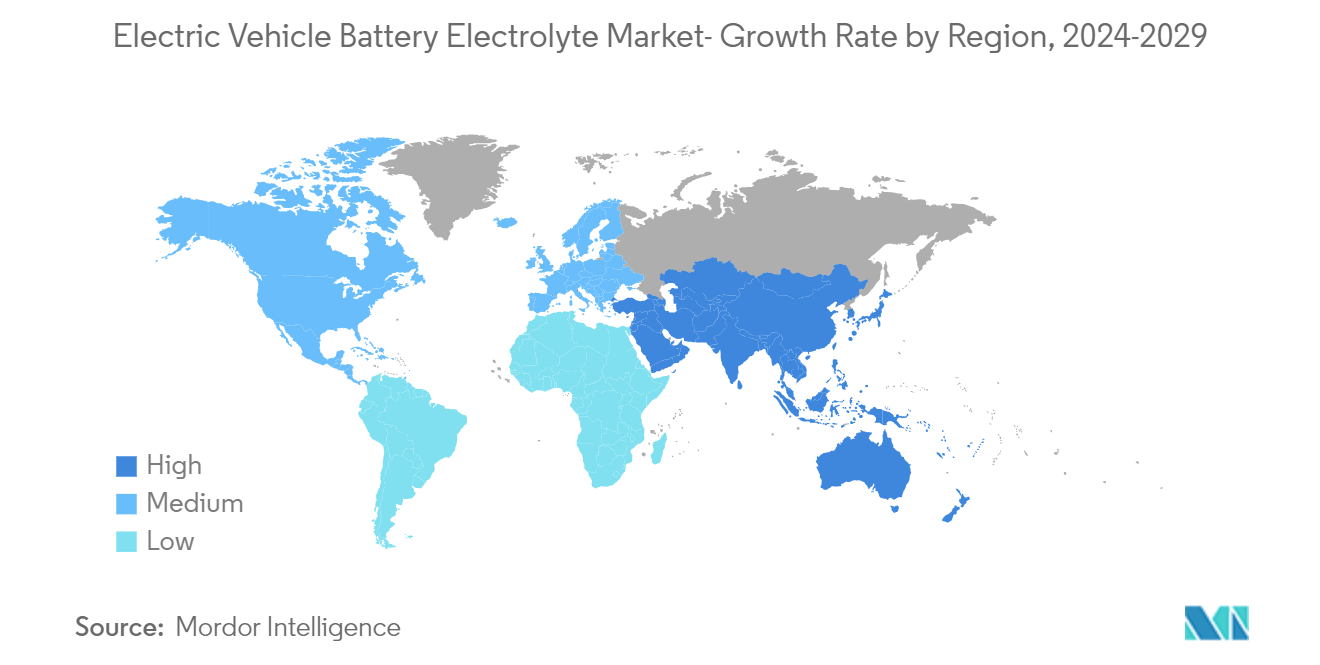
Electric Vehicle Battery Electrolyte Industry Overview
The electric vehicle battery electrolyte market is semi-consolidated. Some of the major players include (not in particular order) Mitsubishi Chemical Group, Sionic Energy, 3M Co., Contemporary Amperex Technology Co. Limited (CATL), and NEI Corporation.
Electric Vehicle Battery Electrolyte Market Leaders
-
Mitsubishi Chemical Group
-
Sionic Energy
-
Contemporary Amperex Technology Co., Limited (CATL)
-
NEI corporation
-
3M Co.
*Disclaimer: Major Players sorted in no particular order
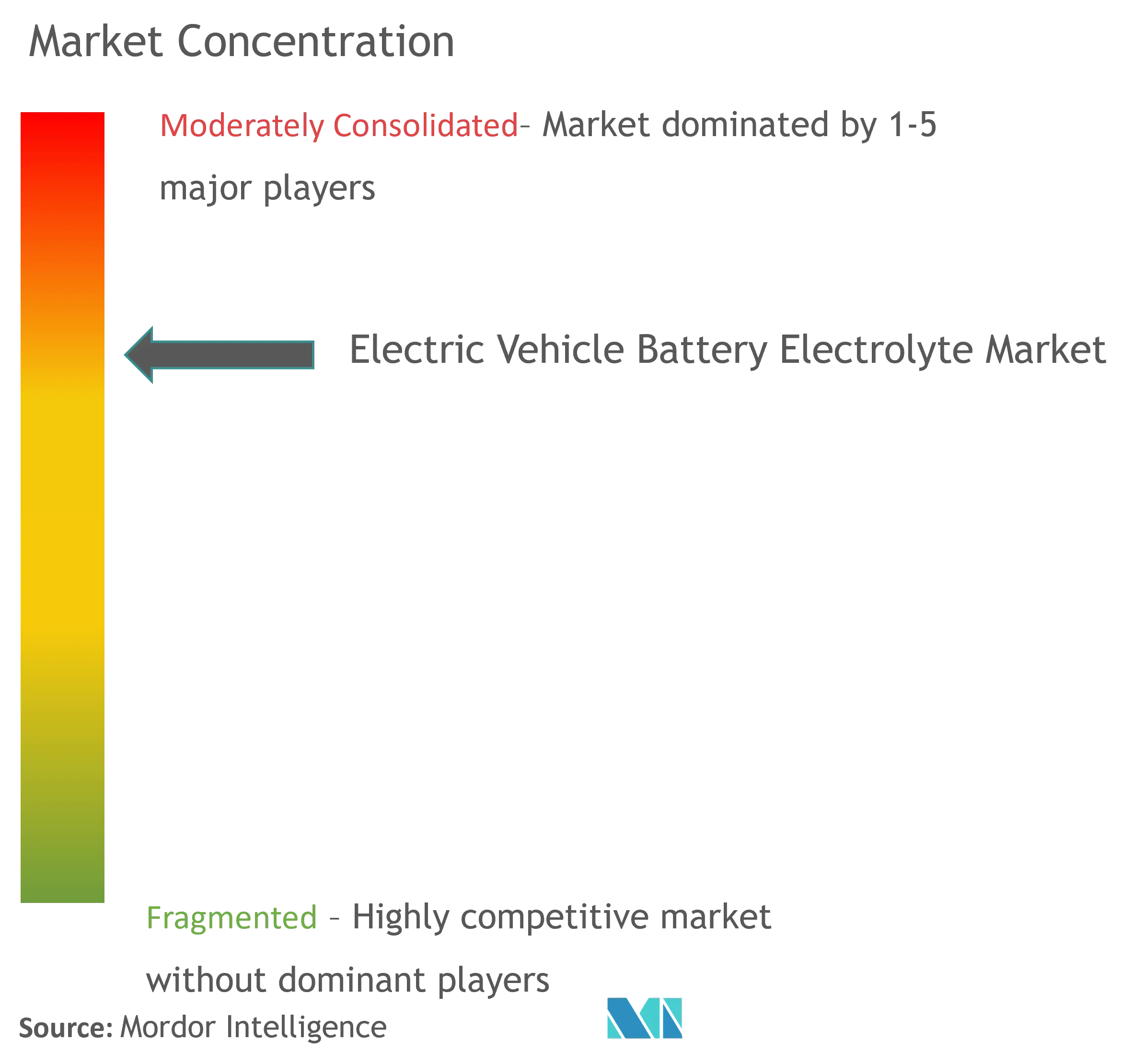
Electric Vehicle Battery Electrolyte Market News
- June 2024: Japanese technology company Asahi Kasei announced the successful proof of concept (POC) for lithium-ion batteries (LIBs) utilizing its proprietary high ionic conductive electrolyte. This technological advancement enhances power output even at low temperatures and improves durability at high temperatures, two critical challenges facing current LIBs. Additionally, this innovation can lead to reduced costs and smaller battery pack sizes, ultimately increasing energy density.
- September 2023: AGC (headquartered in Tokyo; President: Yoshinori Hirai), a global leader in glass, chemicals, and high-tech materials, announced the successful development of a new production technology for sulfide electrolytes used in all-solid-state batteries. AGC aims to refine this process to enable future mass production and enhance the quality of these solid electrolytes for commercialization.
Electric Vehicle Battery Electrolyte Market Report - Table of Contents
1. INTRODUCTION
1.1 Scope of Study
1.2 Market Definition
1.3 Study Assumptions
2. RESEARCH METHODOLOGY
3. EXECUTIVE SUMMARY
4. MARKET OVERVIEW
4.1 Introduction
4.2 Market Size and Demand Forecast in USD billion, till 2029
4.3 Recent Trends and Developments
4.4 Government Policies and Regulations
4.5 Market Dynamics
4.5.1 Drivers
4.5.1.1 Increasing Demand of Electric Vehicles
4.5.1.2 Supportive Government Initiatives
4.5.2 Restraints
4.5.2.1 High Costs of Advanced Electrolytes
4.6 Supply Chain Analysis
4.7 Porter's Five Forces Analysis
4.7.1 Bargaining Power of Suppliers
4.7.2 Bargaining Power of Consumers
4.7.3 Threat of New Entrants
4.7.4 Threat of Substitutes Products and Services
4.7.5 Intensity of Competitive Rivalry
4.8 Investment Analysis
5. MARKET SEGMENTATION
5.1 Battery Type
5.1.1 Lithium-ion Batteries
5.1.2 Lead-acid Batteries
5.1.3 Other Battery Types
5.2 Electrolyte Type
5.2.1 Liquid Electrolyte
5.2.2 Gel Electrolyte
5.2.3 Solid Electrolyte
5.3 Geography
5.3.1 North America
5.3.1.1 United States
5.3.1.2 Canada
5.3.1.3 Rest of North America
5.3.2 Europe
5.3.2.1 Germany
5.3.2.2 France
5.3.2.3 United Kingdom
5.3.2.4 Spain
5.3.2.5 NORDIC
5.3.2.6 Turkey
5.3.2.7 Russia
5.3.2.8 Rest of Europe
5.3.3 Asia-Pacific
5.3.3.1 China
5.3.3.2 India
5.3.3.3 Japan
5.3.3.4 South Korea
5.3.3.5 Thailand
5.3.3.6 Indonesia
5.3.3.7 Vietnam
5.3.3.8 Malaysia
5.3.3.9 Rest of Asia-Pacific
5.3.4 South America
5.3.4.1 Brazil
5.3.4.2 Argentina
5.3.4.3 Colombia
5.3.4.4 Rest of South America
5.3.5 Middle East and Africa
5.3.5.1 Saudi Arabia
5.3.5.2 United Arab Emirates
5.3.5.3 South Africa
5.3.5.4 Egypt
5.3.5.5 Nigeria
5.3.5.6 Qatar
5.3.5.7 Rest of Middle East and Africa
6. COMPETITIVE LANDSCAPE
6.1 Mergers and Acquisitions, Joint Ventures, Collaborations, and Agreements
6.2 Strategies Adopted by Leading Players
6.3 Company Profiles
6.3.1 Mitsubishi Chemical Group
6.3.2 3M Co.
6.3.3 Contemporary Amperex Technology Co. Limited (CATL)
6.3.4 NEI Corporation
6.3.5 Sionic Energy
6.3.6 BASF SE
6.3.7 Solvay SA
6.3.8 UBE Industries Ltd
6.3.9 LG Chem Ltd
6.3.10 Targray Industries Inc.
- *List Not Exhaustive
6.4 Market Ranking/Share Analysis
6.5 List of Other Prominent Companies
7. MARKET OPPORTUNITIES AND FUTURE TRENDS
7.1 Expansion in Emerging Battery Materials
Electric Vehicle Battery Electrolyte Industry Segmentation
An electric vehicle (EV) battery electrolyte is a medium that enables the movement of ions between the cathode and anode of the battery, facilitating the storage and release of electrical energy. It is crucial for the battery's function and performance.
The electric vehicle battery electrolyte market is segmented by battery type, electrolyte type, and geography. By battery type, the market is segmented into lithium-ion batteries, lead-acid batteries, and other battery types. By electrolyte type, the market is segmented into liquid electrolytes, gel electrolytes, and solid electrolytes. The report also covers the market size and forecasts for the electric vehicle battery electrolyte market across major regions.
The market size and forecasts are done for each segment based on value (USD).
| Battery Type | |
| Lithium-ion Batteries | |
| Lead-acid Batteries | |
| Other Battery Types |
| Electrolyte Type | |
| Liquid Electrolyte | |
| Gel Electrolyte | |
| Solid Electrolyte |
| Geography | |||||||||||
| |||||||||||
| |||||||||||
| |||||||||||
| |||||||||||
|
Electric Vehicle Battery Electrolyte Market Research FAQs
How big is the Electric Vehicle Battery Electrolyte Market?
The Electric Vehicle Battery Electrolyte Market size is expected to reach USD 3.81 billion in 2024 and grow at a CAGR of 11.41% to reach USD 6.54 billion by 2029.
What is the current Electric Vehicle Battery Electrolyte Market size?
In 2024, the Electric Vehicle Battery Electrolyte Market size is expected to reach USD 3.81 billion.
Who are the key players in Electric Vehicle Battery Electrolyte Market?
Mitsubishi Chemical Group, Sionic Energy, Contemporary Amperex Technology Co., Limited (CATL), NEI corporation and 3M Co. are the major companies operating in the Electric Vehicle Battery Electrolyte Market.
Which is the fastest growing region in Electric Vehicle Battery Electrolyte Market?
Asia Pacific is estimated to grow at the highest CAGR over the forecast period (2024-2029).
Which region has the biggest share in Electric Vehicle Battery Electrolyte Market?
In 2024, the Asia Pacific accounts for the largest market share in Electric Vehicle Battery Electrolyte Market.
What years does this Electric Vehicle Battery Electrolyte Market cover, and what was the market size in 2023?
In 2023, the Electric Vehicle Battery Electrolyte Market size was estimated at USD 3.38 billion. The report covers the Electric Vehicle Battery Electrolyte Market historical market size for years: 2019, 2020, 2021, 2022 and 2023. The report also forecasts the Electric Vehicle Battery Electrolyte Market size for years: 2024, 2025, 2026, 2027, 2028 and 2029.
Electric Vehicle Battery Electrolyte Industry Report
Statistics for the 2024 Electric Vehicle Battery Electrolyte market share, size and revenue growth rate, created by Mordor Intelligence™ Industry Reports. Electric Vehicle Battery Electrolyte analysis includes a market forecast outlook for 2024 to 2029 and historical overview. Get a sample of this industry analysis as a free report PDF download.



